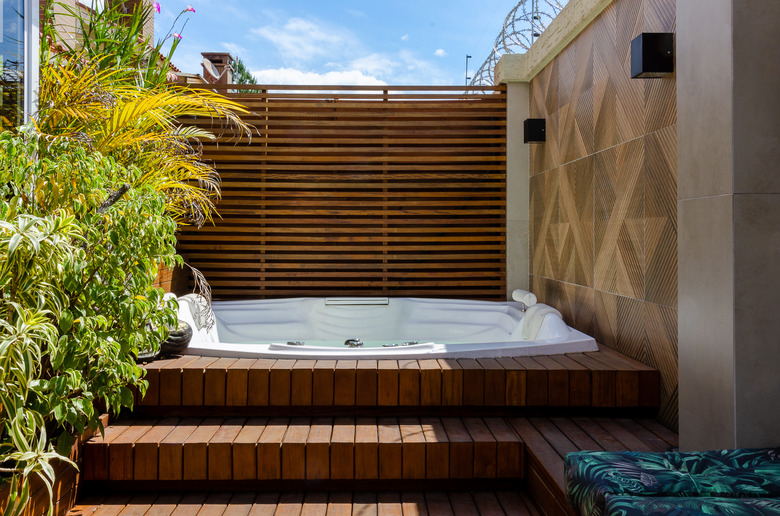How To Get Rid Of Hard Water In A Hot Tub
We may receive a commission on purchases made from links.
When your spa is leaving a gritty surface on its walls so that it feels like you are leaning against sandpaper when you sink in, you know your hot tub water has succumbed to a calcium buildup. Too much calcium is caused by hard water and is called "scaling," creating particles that separate and float or stick to the sides.
This is a common problem in hot tubs and an easy fix. Reach for the right chemicals to prevent it. If it's too far gone, however, you should drain the tub and start over.
What Causes Hard Water?
What Causes Hard Water?
Hard water happens. It generally occurs when water that is rich in minerals, like calcium and magnesium, is heated. The amount of mineral content in water varies widely across the U.S. and depends on the municipality and the rivers, lakes, or streams from which it gets its water. It's not dangerous to your health, and it's not caustic like chlorine or peroxide.
A high level of minerals in water is what makes it "hard." Some hot tub experts use the term "total hardness" to describe both calcium and magnesium buildup, and some spa test strips then measure for total hardness rather than just calcium hardness. This doesn't really matter, as a high level of total hardness will also indicate too much calcium in the water.
Why Calcium Buildup Is Bad for Spas
Why Calcium Buildup Is Bad for Spas
The word "calcium" has a benign sound, as everyone knows it helps build strong bones and teeth, and many people take supplements to ensure that they have enough. But in a hot tub, too much calcium results in scale buildup, which you can see on the sides, in the filter, and on the jets.
You can wipe these clean when you empty the hot tub, but if scale builds up in the pipes or the pump's impeller, you can't see or clean these, so you may be looking at an expensive repair down the road if you don't address the buildup in the short term.
In addition, hard water impacts pH and alkalinity levels, which can negatively affect your entire tub's healthy chemistry. However — and this is important — calcium in a hot tub should be a little on the high side because water that is too soft can also chew up your hot tub shell and its pipes. The appropriate level of calcium in your hot tub is 175 to 250 parts per million, or ppm.
Managing Calcium Buildup
Managing Calcium Buildup
Before addressing your calcium scale problem, look at the pH and alkalinity because pH that is too high can result in calcium buildup. Alkalinity should be between 80 and 120 ppm, while the pH range should be 7.4 to 7.6. Ideally, use test strips that report calcium levels, pH, and alkalinity as well as the level of sanitizing chemicals (usually chlorine, bromine, or peroxide) in your hot tub.
If you live in an area with known hard water, consider adding a filter to your hose to remove calcium before filling the tub. You can also add water softener to the tub. Then, on an ongoing basis, treat your tub with a calcium-reducer product.
It's important to always test the water before treating any assumed imbalances. If the calcium level is higher than 250 ppm, take action. Be sure to read the product directions to ensure that you don't overcorrect.
But remember: Maintaining a hot tub takes work. If the buildup is major, you'll need to drain the hot tub, scrub it clean, refill it, and add new chemicals. And you should be draining, cleaning, and refilling your hot tub about every three months anyway. But the good news is that you can always start fresh if your spa has developed a chemical imbalance, including calcium scale.
